The Spanish
Circle
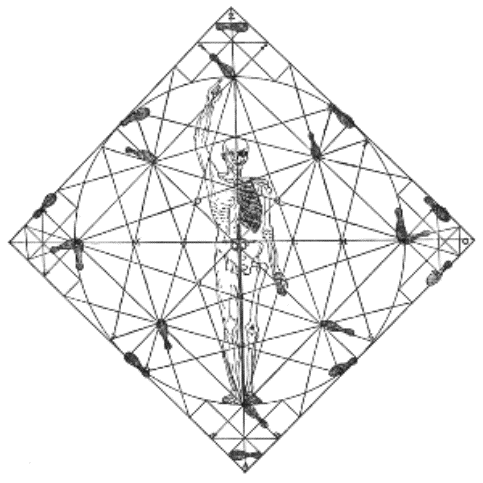
Girard Thibault's
Circle Diagram
An examination of the
mysteries, background and period use of the
Spanish Circle also known as
La Destreza
As researched by HL John
James MacCrimmon
For the Caidian Rapier
Academy (AS XXXV, CE 2000)
Disclaimer:
The opinions stated within the context of
this course and this text, are those of the author. They have been developed after years of research, study and
applied theory. Even so, I do not claim
to be a master of the Spanish Circle.
For me to make such claims would merely state that I have decided I’ve
learned everything there is to know of a subject. I do not claim full knowledge of all the historical or fighting
elements of the Spanish Circle, only the desire to learn more. What I am presenting are techniques I’ve
discovered, practiced and my personal theories of how these methods were
practiced.
I
also give credit were credit is due.
Much of the material here was found on-line,
in
the research of other fencing enthusiasts.
I have included a full bibliography, including links to on-line sites
I’ve used.
Introduction:
At the end of the 16th Century,
one of the deadliest, most elegant, and certainly most misunderstood forms of
rapier combat was being perfected. Its
genesis did not originate on the streets of London, the salle’s of Paris or the
academies of Italy, where the Renaissance was in full flower. Instead, born of war and a unique cultural
development, the Spanish Circle or La Destreza developed and captured the
imagination of fencers in Spain.
Sometimes called the Magic Circle, due its master’s ability to
completely manipulate a duel, this style inspired fear in those who faced it
and awe in those who saw it properly employed.
It was a proscribed method of fighting that successfully endured for
nearly 250 years after the rapier had been displaced throughout the rest of
Europe.
What was the Spanish Circle? Why was it so successful for such a long period? Lastly, what made this style of rapier
combat difficult to understand? Many of
these questions will be addressed in this class. The answers may not be as surprising as some of the mysteries
surrounding them.
This course will attempt to clear up some
of the points of confusion, misinformation, and outright fallacies surrounding
the Destreza. Some of the slanted views
have given the impression that the style was stiff and artificial. These fail to show it’s dynamic and
practical applications in period, which made it so effective. Some of these incorrect aspects included:
·
That
both fencers remained within a given circular area,
·
That
mysticism and magic took the place of good combat sense,
·
And,
that the Destreza promoted a rigid stance which hindered mobility.
Until recently, much of what of commonly
known about the Spanish Circle came from
the
manual of Girard Thibault of Antwerp.
His Academie de L’Espee’,
published in 1628, borrowed heavily from and expounded upon the works of
Jeronimo de Caranza, and his student Don Luis Pacheco de Narvaez. Caranza was recognized as the founder of the
Spanish School and wrote of it in his De
La Filosofia de las Armes (1583).
Narvaez quantified many of Caranza’s teachings and philosophies
regarding the Destreza in his Libro de
las Grandezas de la Espada in 1600. It’s ironic to note, but this researcher found no notes or trace
that Thibault was himself a fencing master or even picked up a rapier. It could be said, then that Thibault was
writing a “how-to” book on something he only had a passing knowledge of. Many of the observation were fundamentally
correct in his text, but lacked clear descriptions or practical application.
Spanish History vs. Strictly Fencing History
The course will address the likely
development of this style and in the context of Spanish history. Rather than be treated as a separate entity,
the Destreza owes its origins and practice to the culture it developed from. All too frequently we only study the styles,
formats and fashions of fighting. We
conveniently clump together concepts of how a particular attack or guard would
have looked or functioned, and make the conclusion that this what we should do. This fails to look at the why it was
done, or what caused it. We as
historical fencers and researchers need to look at the broader view of what we
represent, to see how the society and technology affects things.
The Spanish Kingdom’s rich history colored
the knowledge and experience of the fencers who came from its lands. Though the Renaissance barely affected
Spain, it’s nobles and wealthy middle classes were highly educated and
knowledgeable in many subjects. The
Church taught many of lay folk in the healing arts. Much of this healing knowledge (unfortunately) came as the result
of the Inquisition. The rules of
Inquisitorial questioning required that any injuries must be healed (as best as
possible) should the victim profess innocence.
On a darker note, the Inquisition also taught Spaniards where the body
was most vulnerable to critical injury and rapid death.
The mind of the period Spaniard was also
educated in matters of science. In
various schools and universities, they learned about the philosophies of the
ancient Romans and Greeks from the Marannos (Converted Jews). Matters of mathematics and geometry were
taught by the Mariscos (Converted Moors).
The Crown, through various military actions
(internal and external) gave many young gentlemen of Spain practical fighting
experience. As experience counts for
something, it should be noted that Spain was at war throughout the Renaissance:
1492 - Grenada conquered (End of the
Iberian Moorish Kingdoms)
1519 - Aztecs conquered
1528 - Incas conquered
1567 - Low Countries in revolt
(lasts till 1609)
1569 - Morisco revolt quelled
1571 - Battle of Lepanto (Turks
defeated off Greece)
1588 - Battle of Gravelines (The
Armada)
1608 - Moriscos revolt again
These
are just the highlights, and don't include the various battles and actions by
the Portuguese (a part of Spain of period) in the Americas, India and the Far
East.
Walking in Circles and
Fighting by Tangents
When taken in context, the Destreza was
radically different than any techniques being touted by the Italian masters or
their French contemporaries. During
this era, the use of the lunge was not common, having only been introduced by
Angelo Viggiani in 1575 (Lo Schermo). Instead, fighters used a pass-step to close
the distance between themselves and their opponent. These pass steps, frequently initiated from the broad foot
stance, left little ability to take an addition step toward the target without
dangerously losing balance or committing to an attack.
Most attacks in the Italian style involved a rush or a beat to remove the opponent's sword from the line of attack. They did not teach or advocate the use of a sword parry as we know it today. Instead, they stressed the use of a strong counter-attack, hence the saying "the best defense is a good offense." Consider also that the functional thrust, prior to Viggiani and Saviolo, was delivered as a punching action from the shoulder to extend the range of the weapon, rather than by extending a step into the opponent.
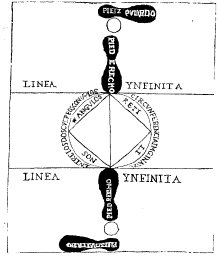
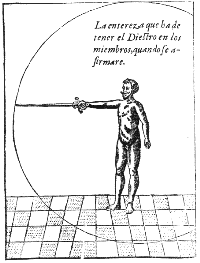
The Spanish masters stressed knowing the
effective range of the weapon and using this to advantage. As each fighter is different in their size
and reach, they taught their students to envision the effective range of their
sword to include a small step or lunge toward the opponent. This range then formed a circle around the
Spaniard and likewise encircled their opponent. The effective range would be a distance or a chord measured from
the base of the leading foot (typically the right) to an arm's length over the
fighter's head. Narvaez, in his Libro, gave a very generalized
measure of this range and description of the circle (see Fig 1 & 2). Thibault's circle directs the fencer on how
to envision their effective range and the circle around their adversary in
great detail (see the cover).
Unfortunately, both examples don't show dimension or depth.
Fig 1 Narvaez’ Circle Fig 2 Guard position from Narvaez' treatise

Perhaps the best
representation of the effective circle (or circles) of range is taken from the
manual of Frederico Ghisliero, Regole
do Molti Cavagliereschi Esserciti (1587). He was a contemporary of
Caranza and the rare exception of the Italian masters. Though his circle is smaller in size (Fig
3), it's three dimensional depiction is far more descriptive.
Fig 3. Note the floor rings, the blade dimensions and hilts, the foot positions,
and the dagger hand stance and parry. The starting position of the defender is to
the far right. Note the opponent's weapon has been driven off the line of attack.
What has frequently been misunderstood
about the circle, was that each fighter stood within their own circle. These circles then moved with the fighter as
they moved. When circles overlapped,
they presented moments of opportunity and danger depending on how the fighters
manipulated their lines of attack.
Thibault's complex line diagrams show, from various positions where
various attacks can be launched with minimal risk of counter-attack.
Another
difference between the Italian and the Spanish style, is the Destreza taught
fighters that the best defense was to get out of the way of the attack. Staying out of the opponent's circle, except
when attacking or exploiting weakness, was key to success. Many defensive moves were simple voids and
slanted retreats, executed to remove the fencer from the line of attack. Attacks essentially were shallow lunges,
voids, slopes and Punto Reverso's, closing range, but all the while angling
away from the opponent. This allowed
the Spaniard to traverse the chords or edges of the opponent's circle, attack,
then move back out to safety.
If it hasn't become apparent, movement was
a major part of the Magic Circle.
Movement along the circle for the most part was clockwise to the fencers
left. This is best illustrated by
Thibault's stepping diagrams, which show footsteps moving clockwise. These clockwise movements forced the
opponent into constantly changing their angle of attack. It removed effectiveness of any secondary
the opponent hand had taking it out of range.
Moreover, it gave the Spaniard the chance the attack on shorter tangent
to the enemy while they moved in and out of the opponent's circle. Most importantly, it fit into the highly
defensive Spanish style, by presenting a smaller profiled target at all times
The Dance of Death
The
Spanish school stressed cool demeanor under pressure, and practiced maneuver
and footwork to control the conduct of the fight. It also taught that instilling a sense of fear or menace granted
the Spaniard a further advantage over their opponent.
The
Destreza taught swordsmen to maintain the menacing stance so frequently
associated with the Spanish style of fighting.
The stance, known as, the Diestro,
(see
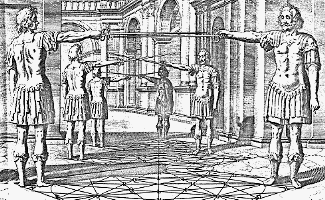
Fig
4) showed the smallest profile of the fighter to their enemy. The body would to turned to semi-profiled
position, heels only slightly apart (see Fig 1), while standing in a relaxed
stance.
Fig 4
The Diestro from Thibault's treasise
The sword arm is extended horizontal to the
ground, sword held at arm's length. The
weapon's tip would then be pointed at the guard of the opponent's sword, or
leveled at the opponent's eyes. From
this position, the defender is threatened by any move towards the fighter
maintaining the Diestro.
From
the Diestro, the fencer could use
subtle movements of their body to direct or lead the movements of their
adversary into positions where the Spaniard could attack with success and
safety. They could also easily step out
of the line of attack by a single step off either foot. Attacks could also easily be launched from
this stance, by stepping toward the opponent or across one of the chords of
their circle. Though not a true lunge,
from this closed stance, great range could be attained in the step towards the
enemy.
Using
subtle twists of the wrist, elbow and shoulder, the Spaniard could gain
leveraged control over the opponent’s blade, or Atajo, and change their enemy's angle of the attack during
engagements. To gain Atajo, the Spanish masters stressed
mastering the feel, or Tacto, of the
opponent’s weapon through their own sword.
Done properly, Tacto allowed
the fencer to read the strengths and weaknesses of the opponent’s guard or
attack. Once these strengths and
weaknesses were realized, the Spaniard could, as if by magic, respond to the
opponent even before the attack began.
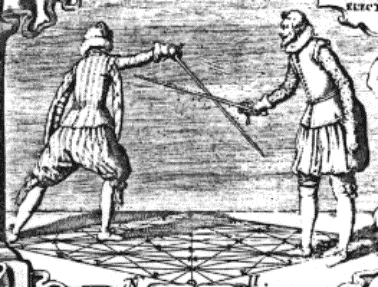
The
Desvio is the closest thing to the
traditional parry as we think of it today.
"Desvio" literally
means to change the course, parry or deflect.
Properly done, it allowed the fighter to deflect their opponent’s sword,
while putting their own in position to either impale the on-coming attacker or
to counter-attack (see Fig 5) with a simple step lunge.
Fig 5 The Desvio;
note the defender (at right) has taken the
attacker off their line of attack, and left themself positioned to
stop-thrust their opponent
The
Philosophy of the Fight
The
Spanish school’s philosophy of the fight, extended even beyond the actions of
the duel, but also included an understanding of what made the opponent
tick. It employed subtle methods to
unhinge the resolve or concentration of the opponents they faced. Students of the Destreza, learned to observe
the enemy to better gauge their strengths and expected courses of action. It’s defensive nature readily lent itself to
this observation and calculated counter-action. Overall, it gave the Spaniard an appearance of cold indifference.
After several unsuccessful attacks, even the most seasoned duelist might have
second thoughts about fighting an apparently unconcerned but well defended
opponent.
The
Spanish school also taught by observing the opponent’s style of combat, they
could be prepared for their attacks and defense. This also extended to the personal style of the attacker. Then as now, fencers gravitated to specific
style/technique combinations (aggressive fighter, the counter-puncher, the
sniper, the overly cautious, etc.).
Observation allowed the Spaniard to use the weakness of the enemy’s
style against them. Thibault notes the
use of colorful descriptions of the styles and methods the fencer could see in
the course of their fighting. These
descriptives were used to paint an easily remembered picture in the mind’s
eye. For example, rather than saying
that a fencer is fighting from a deeply refused guard (Saviolo), the Destreza
could call this the Drunkard’s Ward. As
what is translated of Thibault’s text, doesn’t lend itself to easy description,
the closest description I can find to describe these forms is in Miyamoto
Musashi’s, The Book of Five Rings (1643). Ironically, Musashi wrote this book at age
60, after the Spanish and Portuguese had been in contact with Japan for some 90
years – coincidence perhaps?
The
Spanish also knew that instilling fear and gaining the psychological advantage
against their opponent through the Diestro
wasn’t always enough. Active measures
were also taken. “The (Spanish) Kiss”,
and quick thrust/cut to the nose or mouth, was a truly devastating attack
whether lethal or disabling to the opponent.
Though the direct reference is post-period, it is easy to assume that
from position of the Diestro, this
would attack have been a preferred opening (or closing, as the case may be) line
of attack a Spaniard would take. Even
if the blow stuck wasn’t fatal, the split nose or lips would bleed heavily and
the pain would be terribly disabling. A
missed blow, would give the opponent great hesitancy to engage in rush in
closer for fear of further riposte’ to the face.
Distinctions of Style
What made the Spanish Style of fencing so
respected if not feared by contemporaries of that period, was it the attitude,
the demeanor of the Spaniard, the precision of the attacks and parries, or was
there something more? Consider that in
a time frame where thousands died yearly from duels (in many cases, both
parties of the duel), many Spanish trained fighters walked away without
grievous or life-threatening injuries.
A bit of philosophy here… If I see someone usually winning and
coming away virtually unscathed from a fight, I’m not going to want to play
with them. This appearance gave the
Spaniard something equivalent to instant fame and an aura of invincibility
where rapier combat was concerned. Considering many duels were matters of passion or honor, people
might think twice before challenging a known student of the Destreza.
Because of the Spanish constant interest in
warfare, they learned some valuable lessons about fighting. In wars, you can’t afford to lose a large
amount of the fighting force and expect to win repeatedly; the same applies to
their philosophy of dueling. The
Spanish trained their fighters to come back alive though solid defense. Experience and education showed them how and
where to hit their opponent to quickly put them out of the fight. From the available texts and accounts,
students of the Destreza were taught to hit the vital organs or major nerve
centers as primary target areas. An
enemy, who can’t function, can’t take you with them in death, but this was
easier said then done. Or was it?
In the beginning, I noted that education,
background and experience help round out the Spanish trained fencer, but
there’s one part still missing from the puzzle - the weapon. In the past five years, I’ve managed to
observe four Spanish rapiers from in period or just afterward. Three of the four bore what at first
appeared to small gouges or dents in blades.
These started from the tip of the sword down about six to eight inches
on either cutting edge. The blunted
areas appeared at regular intervals rather than random locations, giving the
impression that they were intentionally placed, thus serrating the blade. A sharp knife or sword will easily puncture
the body; however, the deadly the wound they inflict, incapacitation may not be
immediate. In a duel, this could allow
a fatally wounded opponent to also wound or kill the “victor.” A serrated weapon will not only produce the
same fatal wounds, but it will also cause shock, which incapacitates and
quickly downs the victim. Given the
Spanish knowledge of anatomy, and their understanding that an incapacitated
opponent could not cause them further, fatal harm, it is reasonable to assume
that the swords were burred or serrated intentionally
Conclusions
For a weapons style and method decried my
many historians, the Spanish or Magic Circle, proved to be such an effective
technique, that it’s use lasted until the mid-1800’s. The elegance, style and unique nature of this school of rapier
made it legendary in the annals of historical fencing, rather then a unique
footnote. It seems ironic that this
style of fencing lived on after it was supplanted, in another uniquely Spanish
pastime – the arena of the matador and the bullfight.
About the Author
HL
John James MacCrimmon (AoA, GoA – Goute de Sange of An Tir; twice member of HRM
An Tir’s Rapier Guard; and former Regional Rapier Marshal in both An Tir and
the MidRealm) has been actively fencing in the SCA for nearly ten years. When not on voyages aggressively pursuing
merchantman (read pirating) duties for his Uncle Samuel, John James can be
found either fighting in or heralding the lists of various tournaments. Mundanely, Capt. J.B. Smith is a research
and telemetry instructor navigator in the USAF. He is assigned to the Flight Test Center at Edwards AFB, and
flies various C-135 and Boeing 707 test aircraft.
Bibliography
Coe, Conolly, Harding, Harris, LaRocca, North, Spring and Wilkerson
Swords
and Hilt Weapons
1996, ISBN: 1-56619-249-8
Historical Armed Combat Association (Angelo, Sydney)
Introduction to Frederico Ghisliero’s Rapier Text of 1587 (On-line Article)
1999, http://www.thehaca.com/essays/regole.htm
Ramon Martinez (Maestro)
The
Demystification of the Spanish School (On-line Article, in 3 parts)
2000, http://www.martinez-destreza.com/articles/spanish1.htm
F. Braun McAsh
Ye Arte & Practif of Ye
Rapier, A manual of Historic Rapier Combat, Second Ed.
R.R. Palmer & Joel Colton
A
History of the Modern World, to 1815, 6th Ed
1984, ISBN: 0-394-33599-6 (vol 1)
Daniel Willens
The Mysterious Circle (On-line Article)
1998, http://www.jau.ucc.nau.edu/~wew/other/magic_circle.html
Miyomoto Musushi
The Book of Five Rings (Thomas Cleary translation)
1994, ISBN 0-87773-998-6
Bibliography for the Realistic Wounds Class as taught by HL John James MacCrimmon
William Ernoehazy Jr., (Don Giovanni di Fiamma)
Reflections on Blow Acknowledgement for the Honorable Duelist in the SCA (On-line Article)
1998, http://www.geocities.com/area51/8370/ThornyIvy/wounds.html
F. Braun McAsh
Ye Arte & Practif of Ye
Rapier, A manual of Historic Rapier Combat, Second Ed.
George Silver
Brief Instructions to my
Paradoxes of Defense: Admonitions to
the Gentlemen
and Brave Gallants of Great Britain against Quarrels and Brawls
http://www.aemma.org/onlineResources/silver/briefSilver1.htm